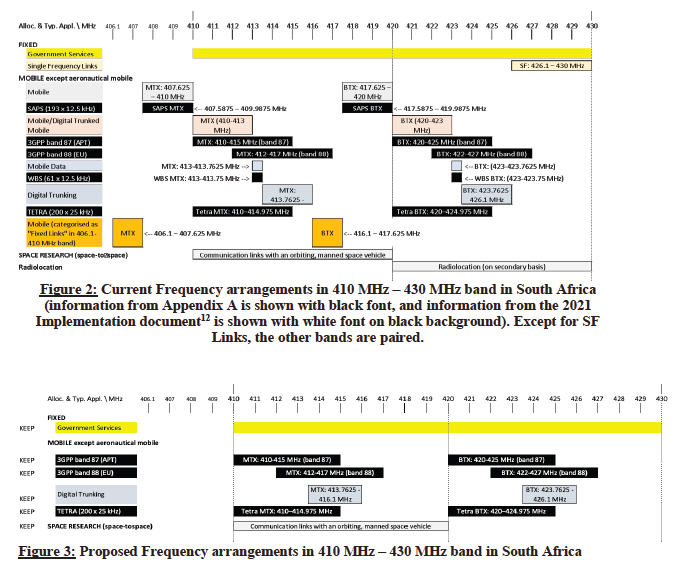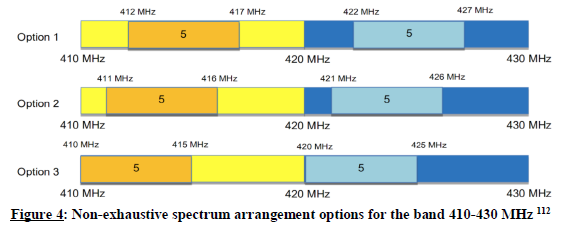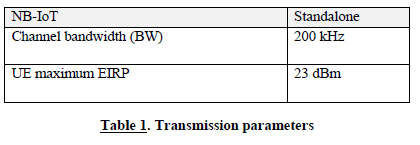 Witness Protection Act, 1998
Witness Protection Act, 1998
R 385
Electronic Communications Act, 2005 (Act No. 36 of 2005)ICASANotice regarding Final Radio Frequency Assignment Plans for the Frequency Band 410 to 430 MHz in terms of Regulation 3 of the Radio Frequency Spectrum Regulations, 20154. Channelling Plan |
| 4.1 | The frequency band 410 MHz – 430 MHz provides a total bandwidth of 20 MHz. |
| 4.2 | Tables with current channel plans for the band 410 – 430 MHz are available in subsection 1.7 of Appendix G (i.e., on pages 171/293 – 178/293) in the Final Radio Frequency Migration Plan 2019 11. The tables cover the following applications: |
| 1) | SAPS (193 x 12.5 kHz channels, SAPS): |
BTX 417.5875 – 419.9875 MHz (in terms of the centres of the channels), paired with
MTX 407.5875 – 409.9875 MHz
| 2) | DIGITAL TRUNKING (200 x 25 kHz channels, TETRA): |
BTX 420 – 424.975 MHz, paired with
MTX 410 – 414.975 MHz
| 3) | MOBILE DATA (61 X 12.5 kHz channels, WBS): |
BTX 423 – 423.75 MHz, paired with
MTX 413 – 413.75 MHz.
| 4.3 | The channel arrangements for the band are based on Appendix A and shown in Figure 2 and Figure 3 |

| 4.4 | Channelling for non-3GPP analogue and digital land mobile systems |
| 4.4.1 | Channelling for analogue and digital land mobile systems with channel spacing of up to 25 kHz, of 50 kHz, 100 kHz, or 150 kHz, abiding by T/R 25-08 13. |
The channel centre frequencies (hereinafter called centre frequencies) use the following preferred formula. This preferred formula should be used whenever possible, but at least in new and re-farmed bands:
FCH = Band Edge – (Channel Spacing/2) + n × Channel Spacing
Where:
FCH = channel centre frequency
n = 1, 2, 3, … - channel number;
Band Edge is the lower edge of the allocated frequency band, i.e., 410 MHz.
For systems using a channel spacing of 200 kHz, the centre frequencies should be selected according to the preferred formula with an option to offset these centre frequencies by 100 kHz.
| 4.4.2 | Duplex or two-frequency simplex channel separation, location of sub-bands and guard bands14: |
A sub-band can be simplex or duplex. The lower and upper parts of a duplex sub-band should be in the same allocated band.
The frequencies of emissions of base or repeater stations should be placed in the upper band and those of mobile stations in the lower band. The same positions of upper and lower bands should be selected for bordering/adjacent countries.
The channel centre frequency of a digital land mobile system using a channel spacing greater than 25 kHz may be selected in a way that the channel pertaining to the centre frequency with its nominal channel spacing falls entirely into a sub-band and does not overlap the guard band necessary around the edges of simplex sub-bands and the edges of the lower parts and upper parts of duplex sub-bands.
| 4.5 | Non-exhaustive spectrum arrangement options for the band 410-430 MHz |
ECC Report 292 15, “based on the overall considerations,” recommends three options for broadband technologies in the band, illustrated in Figure 4.

| 4.6 | Channelling for land mobile systems with channel bandwidths of 1.25 MHz, 1.4 MHz, 3 MHz, and 5 MHz |
ECC/DEC/ (19)0216, supported by ECC Report 28317, advises on the technical requirements for land mobile systems with the channel bandwidth of 1.25 MHz, 1.4 MHz, 3 MHz, and 5 MHz (for 410-430 MHz)
| 4.6.1 | 1.4 MHz, 3 MHz and 5 MHz LTE FDD channelling arrangements could be implemented in the paired frequency arrangements in 410.0 - 415.0 MHz / 420.0 - 425.0 MHz, 411.0 - 416.0 MHz / 421.0 - 426.0 MHz, and 412.0 - 417.0 MHz / 422.0 - 427.0 MHz. |
| 4.7 | Technical conditions for land mobile systems based on NB-IoT and LPWAN technologies in the 410-430 MHz frequency range, based on ECC/DEC/ (19)0218: |
The following technical conditions shall be applied as an essential component necessary to ensure coexistence between neighbouring networks. Operators may agree, on a bilateral or multilateral basis, different technical parameters providing that they continue to comply with the technical conditions applicable for the protection of other services, applications, or networks and with their cross-border obligations.
The technical requirements are derived from ECC Report 28319.
| 4.7.1 | LTE NB-IOT (STANDALONE) |
ECC/DEC/ (19)0220 advises on the channel bandwidth and frequency offset for NB-IoT standalone operation for a standalone NB-IoT, as summarised in Table 1 and Table 2.


| 4.7.2 | LPWAN |
ECC/DEC/ (19)02}21 advises on the baseline channel bandwidth of 125 kHz to 250 kHz.
| 4.8 | BB-PPDR Channelling |
| 4.8.1 | Introduction |
The 410-420 MHz / 420-430 MHz frequency range does not allow for enough available spectrum to provide for a stand-alone solution requiring 2 x 10 MHz for BB-PPDR as calculated in ECC Report 199 107.
The range can offer national flexibility, e.g., in the context of additional spectrum beside the 700 MHz range. The 1.4 MHz, 3 MHz and 5 MHz LTE FDD channelling arrangements could be implemented in the paired frequency arrangements in 410.0- 415.0 MHz / 420.0-425.0 MHz, 411.0-416.0 MHz / 421.0-426.0 MHz and 412.0- 417.0 MHz / 422.0-427.0 MHz.
The least restrictive technical conditions (LRTC) set out in this document are derived from ECC Report 283 22.
| 4.8.2 | BB-PPDR channel bandwidths considered by ECC/DEC/ (16)0223: 1.4 MHz, 3 MHz, and 5 MHz. |
________________________________________
| 11 | Final Radio Frequency Migration Plan 2019, Government Gazette No 42337, 29 March 2019 (https://www.icasa.org.za/uploads/files/final-radio-frequency-migration-plan-2019.pdf). |
| 12 | https://www.gov.za/sites/default/files/gcis_document/202112/45690gen739.pdf |
| 13 | Recommendation T/R 25-08, Planning criteria and cross-border coordination of frequencies for land mobile systems in the range 29.7-470 MHz, Approved 15 January 1990. Amended 28 September 2018. (https://docdb.cept.org/document/909, https://docdb.cept.org/download/2544) |
| 14 | ECC Recommendation T/R 25-08, Planning criteria and coordination of frequencies for land mobile systems in the range 29.7-470 MHz. http://spectrum.welter.fr/international/cept/erc-recommendations/erc-recommendation-25-08-public-land-mobile-29-MHz-470-MHz.pdf |
| 15 | ECC Report 292, Current Use, Future Opportunities and Guidance to Administrations for the 400 MHz PMR/PAMR frequencies, 8 February 2019. (https://docdb.cept.org/document/9556) |
| 16 | ECC/DEC/ (19)02, ECC Decision of 8 March 2019 on Land mobile systems in the frequency ranges 68-87.5 MHz, 146- 174 MHz, 406.1-410 MHz, 410-430 MHz, 440-450 MHz, and 450-470 MHz, 8 March 2019. (https://docdb.cept.org/document/9680) |
| 17 | ECC Report 283, Compatibility and sharing studies related to the introduction of broadband and narrowband systems in the bands 410-430 MHz and 450-470 MHz, 14 September 2018. (https://docdb.cept.org/document/6033) |
| 18 | Ibid. |
| 19 | ECC Report 283, Compatibility and sharing studies related to the introduction of broadband and narrowband systems in the bands 410-430 MHz and 450-470 MHz, 14 September 2018. (https://docdb.cept.org/document/6033 |
| 20 | ECC/DEC/ (19)02, ECC Decision of 8 March 2019 on Land mobile systems in the frequency ranges 68-87.5 MHz, 146- 174 MHz, 406.1-410 MHz, 410-430 MHz, 440-450 MHz, and 450-470 MHz, 8 March 2019. (https://docdb.cept.org/document/9680) |
| 21 | Ibid |
| 22 | ECC Report 283, Compatibility and sharing studies related to the introduction of broadband and narrowband systems in the bands 410-430 MHz and 450-470 MHz, 14 September 2018. (https://docdb.cept.org/document/6033) |
| 23 | ECC/DEC/ (16)02, ECC Decision of 17 June 2016 on harmonised technical conditions and frequency bands for the implementation of Broadband Public Protection and Disaster Relief (BB-PPDR) systems. Amended on 8 March 2019. (https://docdb.cept.org/document/941) |